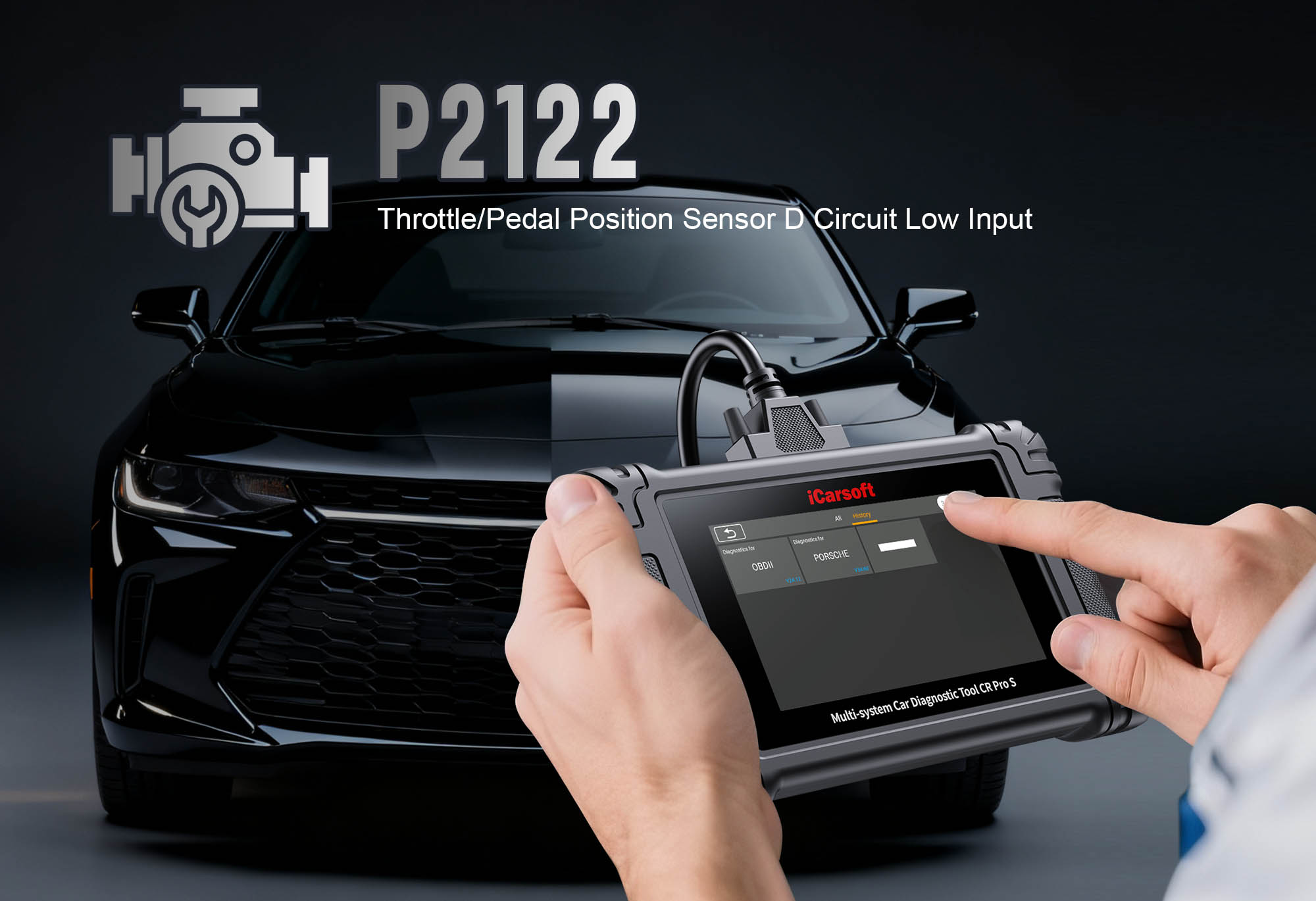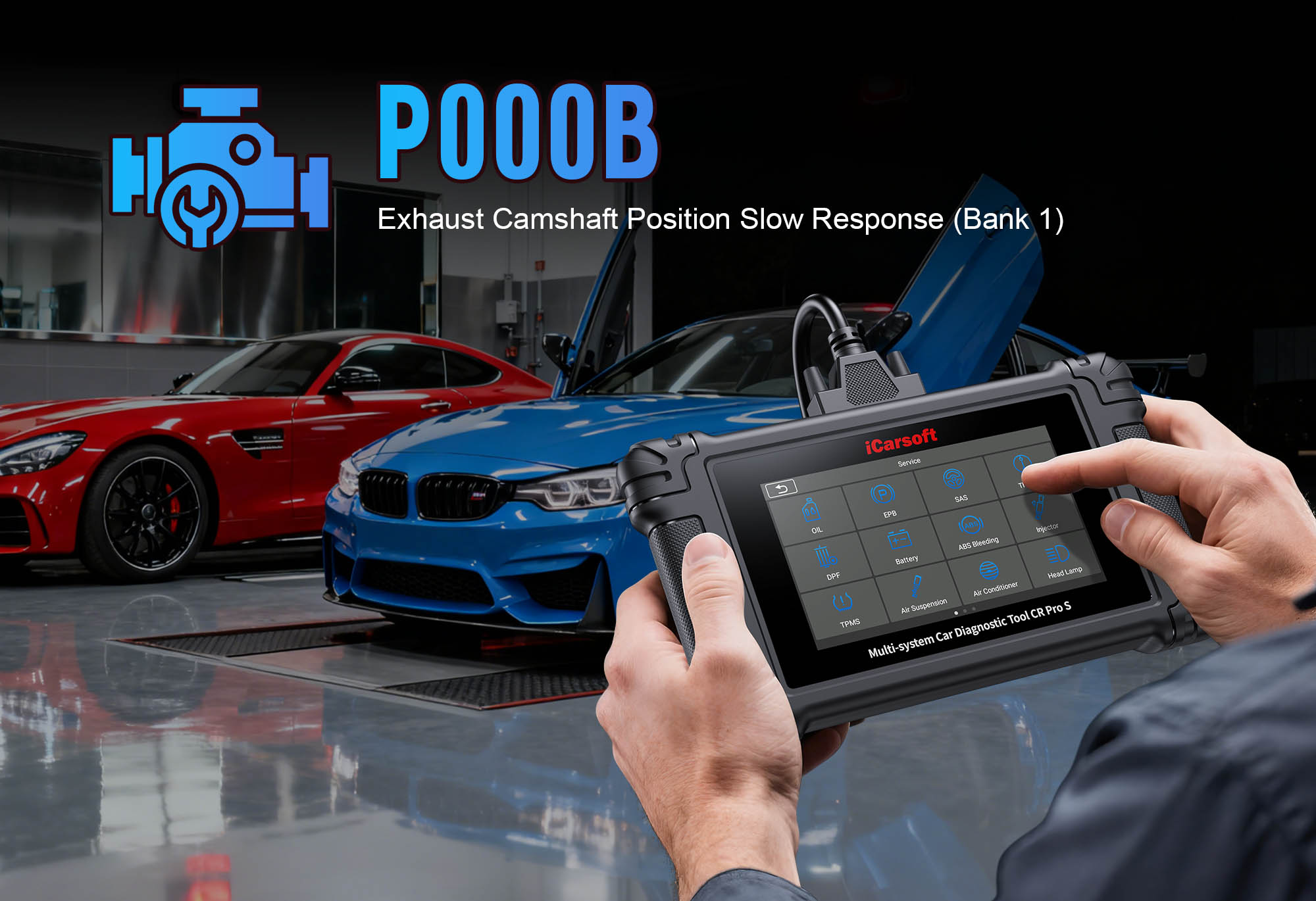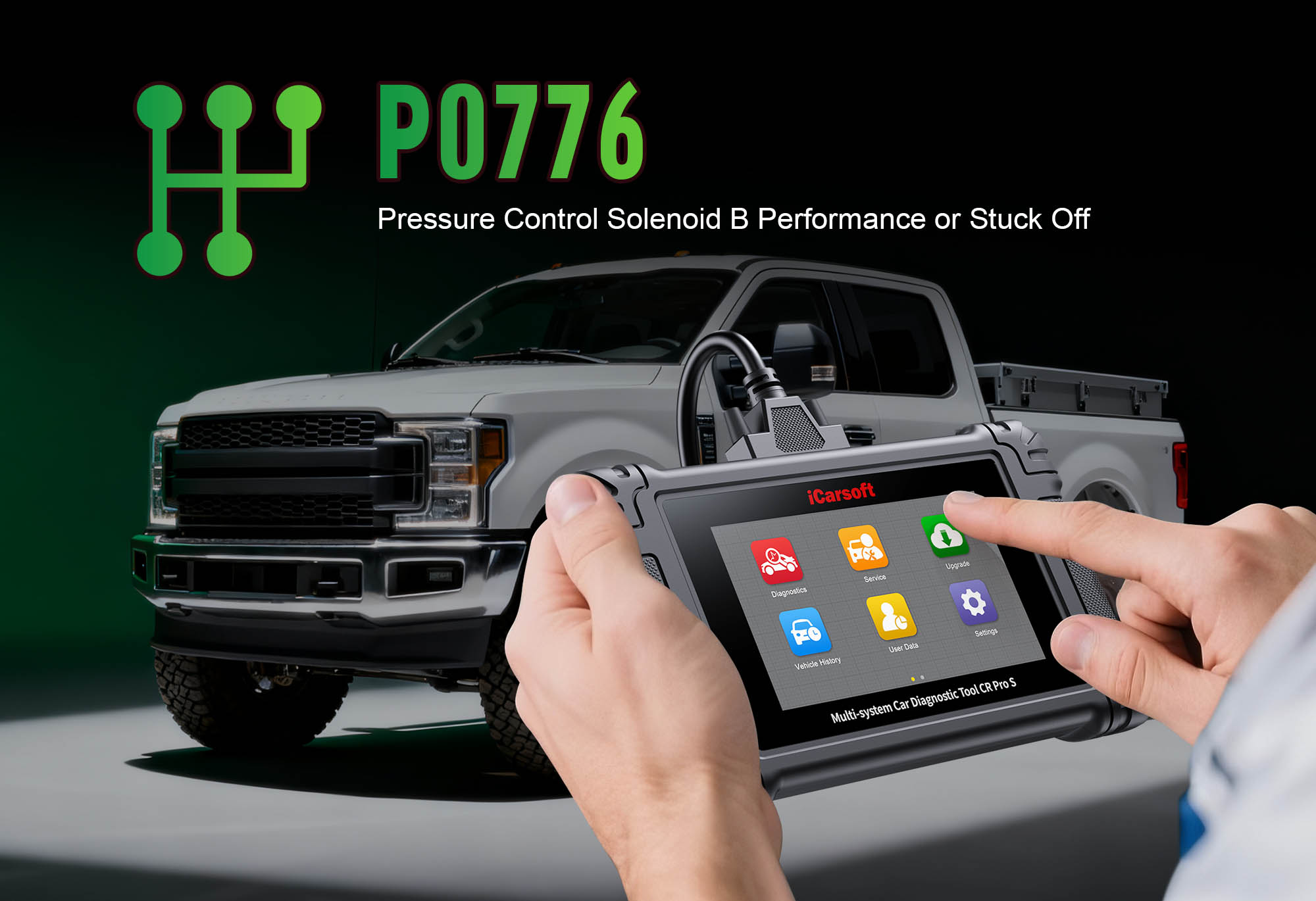P2122 Code: Diagnose & Clear Throttle/Pedal Position Sensor D Circuit Low Input with iCarsoft CR Pro S
If your check engine light turns on and you notice symptoms like unresponsive acceleration, reduced engine power, or even a "limp mode" that limits speed to 30–40 mph, a diagnostic scan will likely return P2122. This OBD-II code stands for "Throttle/Pedal Position Sensor/Switch D Circuit Low Input," indicating the Engine Control Module (ECM) is receiving an abnormally low voltage signal from the throttle pedal position sensor (TPPS)—a critical component that tells the ECM how far you’re pressing the accelerator.
Modern vehicles use electronic throttle control (ETC) systems, replacing mechanical cables with sensors and motors. The throttle pedal has two or more position sensors (labeled A, B, C, D) for redundancy—if one fails, the ECM can rely on others to prevent sudden acceleration or power loss. Sensor D specifically monitors the pedal’s mid-to-high range movement; a "low input" signal (<0.5V, vs. the normal 0.5–4.5V) means the ECM can’t accurately detect pedal position. This forces the ECM to trigger limp mode to protect the engine, as it can’t adjust fuel injection or ignition timing safely.
Basic scanners may only flag "throttle sensor fault" but can’t test sensor redundancy or isolate wiring issues. The iCarsoft CR Pro S, with its ETC system diagnostics, live sensor voltage tracking, and bi-directional throttle tests, solves this. Let’s walk through how to diagnose and resolve P2122 with precision.
Understanding P2122: Causes & Key Symptoms
A faulty Throttle/Pedal Position Sensor D disrupts the ECM’s ability to interpret accelerator input, with symptoms that directly impact drivability—these clues help separate sensor faults from electrical issues.
Key Symptoms of P2122
-
Unresponsive Acceleration: Pressing the pedal doesn’t increase engine power, or power rises slowly (ECM can’t detect pedal position).
-
Reduced Engine Power (Limp Mode): ECM limits RPM to 2,000–3,000 and speed to 30–40 mph to avoid engine damage.
-
Intermittent Power Loss: Symptoms come and go, triggered by vibration (loose connectors) or temperature changes (wiring insulation shrinking).
-
Hard Starting: ECM uses TPPS data for startup fuel adjustment—low input causes extended cranking or rough idle.
-
Erratic Idle: Engine fluctuates between 500–1,000 RPM at idle, due to conflicting signals from redundant sensors.
-
Throttle Warning Light: Vehicles like Ford, GM, or Volkswagen trigger a dedicated "ETC" or "Throttle" light alongside the check engine light.
Common Causes of P2122
|
Cause
|
Description
|
|
Faulty Throttle/Pedal Position Sensor D
|
Internal wear or electrical burnout causes low voltage output—common in vehicles over 100,000 miles.
|
|
Wiring/Connector Issues
|
Corroded terminals, frayed wires, or loose plugs drop voltage; water intrusion often worsens this.
|
|
Damaged Throttle Pedal Assembly
|
Broken springs or worn pivots misalign the sensor, sending incorrect low-input signals.
|
|
ECM Malfunction
|
Outdated firmware or internal faults misinterpret sensor voltage—rare but possible in 2016+ vehicles.
|
|
Low Battery Voltage
|
Weak battery (<12V) reduces power to the TPPS, causing low input signals.
|
|
Short to Ground
|
Sensor circuit wire touches the vehicle chassis (ground), draining voltage and triggering P2122.
|
Why iCarsoft CR Pro S Excels at Diagnosing P2122
The CR Pro S outperforms basic tools with ETC and TPPS-specific features, critical for isolating the root cause of P2122:
Live TPPS Voltage Tracking
Monitors voltage from all TPPS sensors (A/B/C/D) simultaneously, making low input from Sensor D easy to spot.
Sensor Redundancy Checks
Compares Sensor D signals to others (e.g., Sensor B) to confirm if the issue is isolated or system-wide.
Bi-Directional Throttle Tests
Sends commands to the ETC system to test throttle response, verifying ECM functionality.
Global Vehicle Coverage
Works with 500+ models (Mercedes-Benz, BMW, Toyota, Ford) for brand-specific TPPS designs.
Circuit Diagnostics
Includes continuity and short-to-ground tests to isolate electrical issues like frayed wires or corrosion.
Lifetime Free ECM Updates
Wi-Fi updates fix P2122 false triggers from outdated ECM software (common in ETC-recall vehicles).
Step-by-Step: Diagnose P2122 with iCarsoft CR Pro S
-
Check Battery Voltage First
1. Turn off all accessories (lights, radio). Use CR Pro S’s Battery Voltage Test (System > Tools) to measure voltage.
2. Normal = 12.4–12.7V (off) or 13.5–14.5V (running). <12V = weak battery (charge or replace).
-
Connect the CR Pro S & Confirm the Code
1. Plug the CR Pro S into the OBD-II port (use OBDI adaptors for older models: Mercedes 38Pin, BMW 20Pin).
2. Select your vehicle via Auto VIN Identify (instant specs) or manual entry.
3. Navigate to Engine > Fault Codes > Read Codes to confirm P2122. Tap Code Details for tips (e.g., "Ford F-150: Check TPPS D in Accelerator Pedal Assembly").
-
Locate the Throttle Pedal Position Sensor D
1. Go to Component Location > Engine > Electronic Throttle Control > Throttle Pedal Position Sensor (TPPS).
2. Use the diagram to identify:
- Accelerator Pedal Assembly: Sensor D is built-in (replaced as a unit in most vehicles).
- Wiring Harness: Path to ECM (check for damage near floorboard/steering column).
- ECM Connector: TPPS wires connect here (corrosion causes low voltage).
-
Analyze Live TPPS Voltage Data
1. Start the engine, idle (don’t press the accelerator).
2. Navigate to Engine > Live Data > Throttle/Pedal Position and monitor:
- Sensor D Voltage: Idle = 0.5–0.8V. P2122 = <0.5V (low input).
- Redundancy Check: Sensor D should mirror Sensor B (e.g., B=0.6V → D=0.7V). Mismatch = faulty D.
- Pedal Movement Test: Press pedal to 50%—D voltage should rise to 2.0–2.5V. Erratic/no rise = fault.
- ECM Reference Voltage: Should be 5V (under Live Data > ECM Power). <4.8V = ECM issue.
-
Test the TPPS Circuit for Shorts/Continuity
1. Short-to-Ground Test: - Turn off engine, disconnect pedal assembly connector.
- Use Multimeter Function:
- Sensor D signal pin → ground: Normal = infinite resistance. Continuity = shorted wire.
- Sensor D power pin → ground: Normal = 5V (ECM reference). <4.8V = ECM power fault.
2. Continuity Test: - Measure resistance between D’s signal pin and ECM pin (use wiring diagram). Normal = <5 ohms. Higher = frayed wire/corrosion.
3. Connector Inspection: - Clean pedal/ECM connectors with contact cleaner. Check for bent pins/corrosion.
-
Perform Bi-Directional Throttle Tests
1. Throttle Response Test: - Park with parking brake on. Go to Special Functions > Engine > Electronic Throttle Control > Throttle Response Test.
- Simulate pedal presses—throttle plate position should match input (50% pedal → 50% plate). No response = ECM/throttle body fault.
2. TPPS Calibration: - Use TPPS Calibration (Special Functions) to reset sensor alignment—fixes intermittent low input.
-
Inspect the Accelerator Pedal Assembly
1. Physical Inspection: - Remove assembly (follow CR Pro S’s Disassembly Guide). Check for broken springs, worn pivots, or water damage.
2. Sensor Resistance Test: - Use multimeter to measure D’s resistance (specs: 1,000–5,000 ohms). Erratic resistance = faulty sensor (replace assembly).
-
Rule Out ECM Issues
1. ECM Firmware Update: - Go to System > Update Manager to install free updates (fixes misinterpreted TPPS signals).
2. ECM Communication Test: - Verify module receives/sends data. Failed communication = ECM repair (consult professional).
-
Repair & Clear P2122
1. Fix the root cause:
- Faulty TPPS D: Replace accelerator pedal assembly (use Part Lookup).
- Electrical Issues: Splice wires, repair shorts, or replace connectors.
- Low Battery: Charge or replace battery.
- ECM Fault: Update firmware or repair module.
2. Clear the code: Navigate to Engine > Fault Codes > Clear Codes to delete P2122.
-
Validate the Repair
1. Recheck live data: Sensor D = 0.5–0.8V (idle), rises to 4.0–4.5V (full pedal).
2. Test drive: Accelerate from stop to highway speed—no unresponsive power, limp mode, or warnings.
3. Post-drive scan: Use Engine System Scan after 50 miles to confirm P2122 doesn’t return.
Preventing P2122 Recurrence
Use the iCarsoft CR Pro S to maintain TPPS and ETC system health long-term:
-
Battery Maintenance: Set Service Reminder to test the battery every 6 months—weak batteries disrupt sensor power.
-
TPPS Checks: Include the pedal assembly in annual electrical scans—test voltage and continuity to catch early faults.
-
Connector Care: Clean pedal and ECM connectors yearly with contact cleaner (prevents corrosion).
-
ECM Updates: Enable Update Alerts to install firmware fixes for TPPS signal processing.
Conclusion
P2122’s low input from Throttle/Pedal Position Sensor D turns driving into a frustrating (and unsafe) experience—but the iCarsoft CR Pro S simplifies diagnosis with live voltage tracking, circuit tests, and bi-directional controls. Whether replacing a pedal assembly, fixing wiring, or updating the ECM, this tool ensures you fix the root cause (not just replace parts blindly).
With the CR Pro S, you’ll restore responsive acceleration, disable limp mode, and keep your vehicle’s electronic throttle system running reliably—no more unexpected power loss or costly dealer visits.
FAQs About P2122 Code
Q: Can I drive with P2122?
A: Only short distances (e.g., to a repair shop). Limp mode limits speed, and unresponsive acceleration is unsafe on highways. Address P2122 within 1–2 days.
Q: How much does it cost to fix P2122?
A: $150–$300 for an OEM accelerator pedal assembly (with Sensor D); $80–$200 for wiring/connector repairs; $400–$1,000 for ECM repairs. The CR Pro S ($300–$400) saves by avoiding unnecessary ECM replacement.
Q: Will cleaning the throttle body fix P2122?
A: No—P2122 relates to the pedal’s Sensor D, not the throttle body. Cleaning the throttle body fixes issues like rough idle, but won’t resolve low sensor input.
Q: Is P2122 the same as P2127?
A: No—P2122 = "Sensor D Circuit Low Input," while P2127 = "Sensor E Circuit Low Input." The CR Pro S distinguishes them via sensor labeling in live data.




